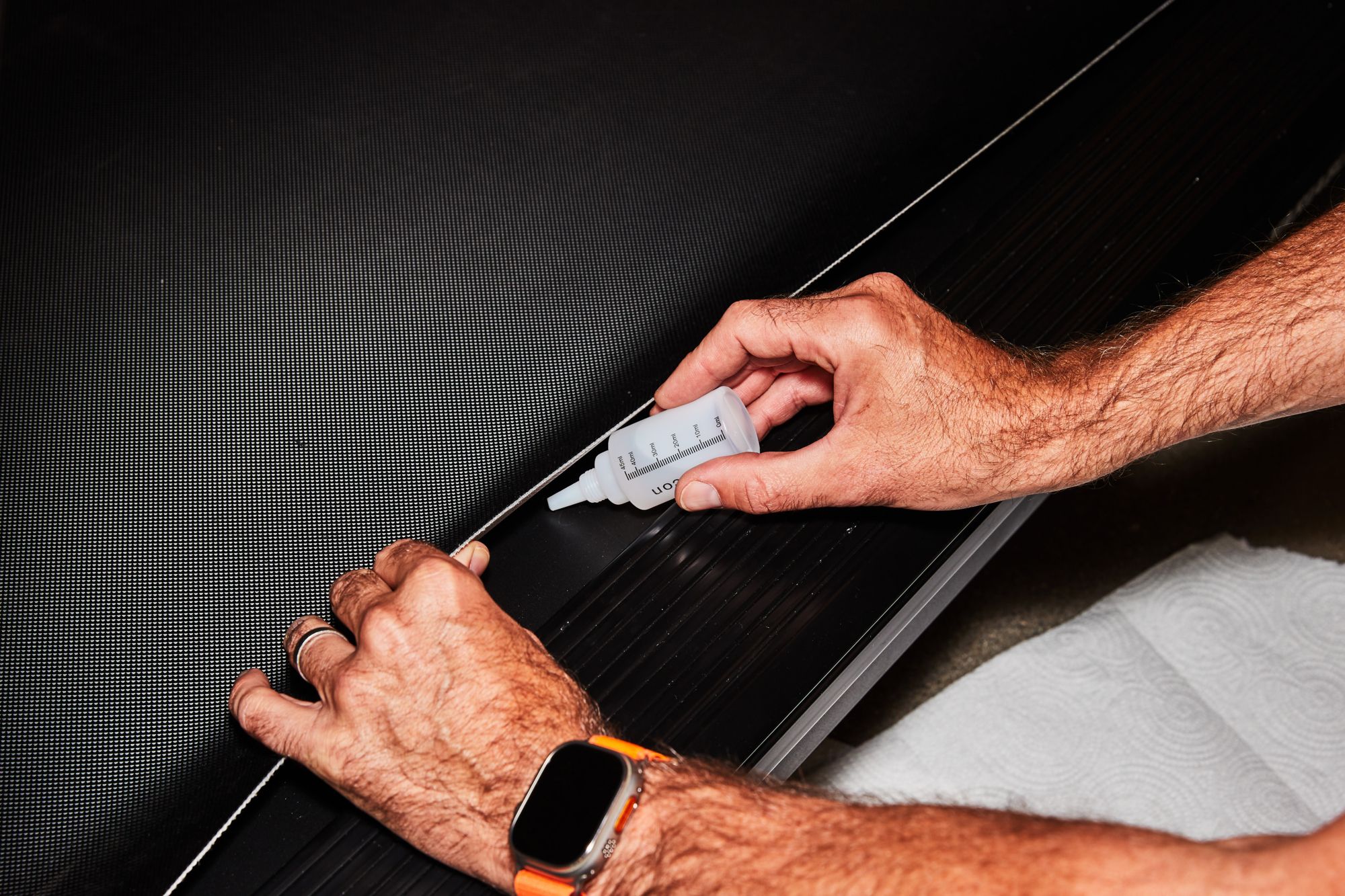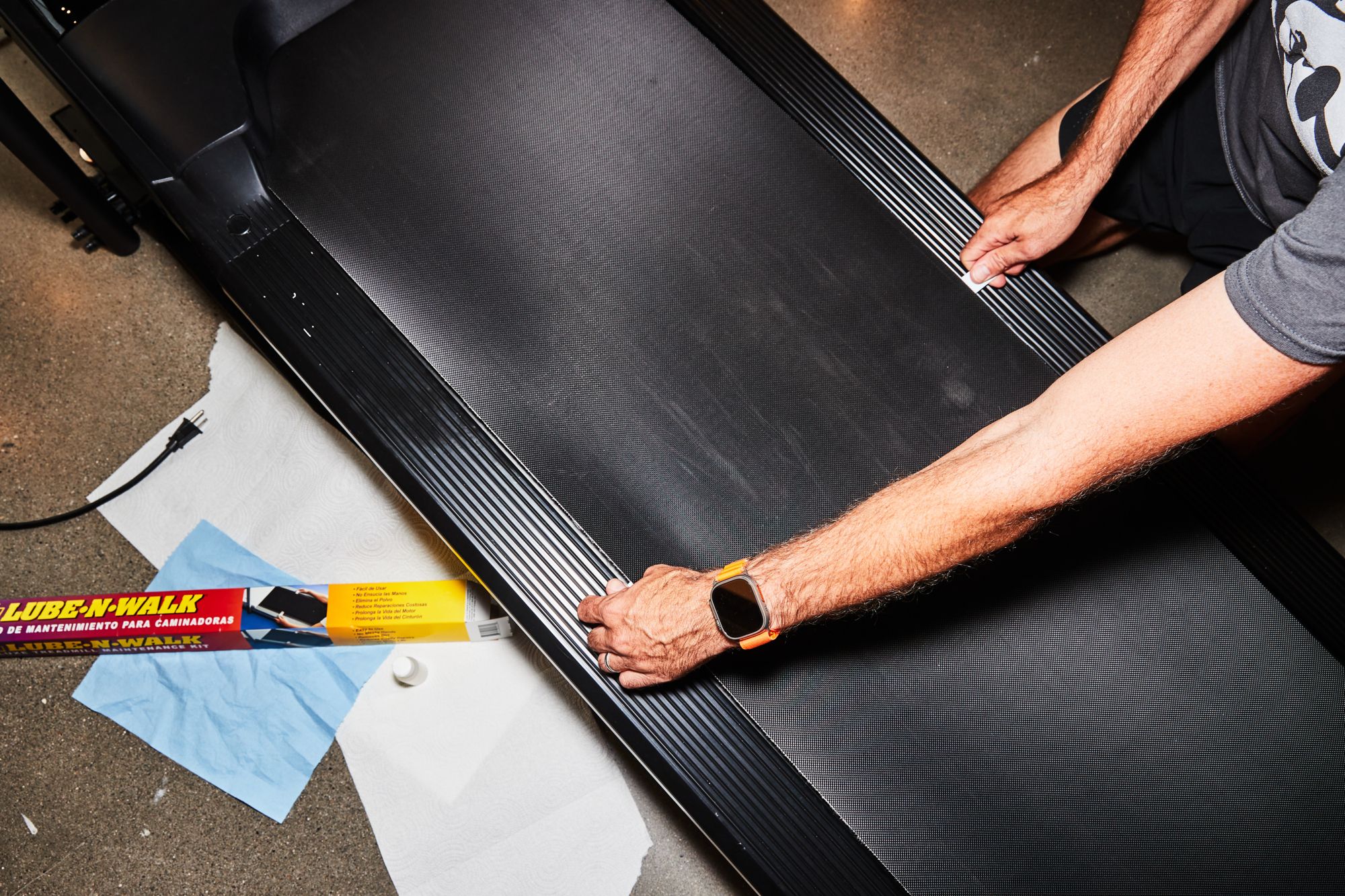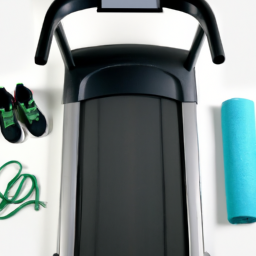Maintaining your treadmill is essential to ensure its longevity and optimal performance. In this article, you will learn the step-by-step process of how to properly lubricate your treadmill. Regularly lubricating your treadmill not only reduces friction but also minimizes wear and tear on the machine, allowing you to enjoy smooth and quiet workouts for years to come. Whether you’re a seasoned fitness enthusiast or just starting your fitness journey, this guide will provide you with all the necessary information to keep your treadmill in excellent shape. So, let’s dive right in and discover how to lube your treadmill like a pro!

This image is property of hips.hearstapps.com.
Why is it important to lube your treadmill?
Prevents friction and wear
Lubricating your treadmill is crucial to prevent friction between the belt and the deck. The constant movement of the belt can generate heat, leading to excessive wear and tear. By applying lubricant, you create a protective layer that reduces the friction, allowing the belt to glide smoothly over the deck.
Reduces noise
A well-lubricated treadmill operates quietly, providing a more pleasant exercising experience. When the belt and deck rub against each other without proper lubrication, it can produce irritating squeaking or squealing noises. Regularly lubricating your treadmill minimizes these sounds and creates a peaceful workout environment.
Extends the life of the treadmill
Proper maintenance, including regular lubrication, can significantly extend the lifespan of your treadmill. The lubricant acts as a protective barrier, reducing the wear on essential components such as the motor, belt, and roller. By keeping these parts lubricated, you can avoid premature damage and costly repairs.
Maintains optimal performance
Regular lubrication ensures that your treadmill maintains its optimal performance. When the belt glides smoothly, you can easily walk, jog, or run without any jerking or resistance. A well-lubricated treadmill also puts less strain on the motor, allowing it to operate more efficiently. Overall, lubrication contributes to a better workout experience and helps you achieve your fitness goals.
Types of lubricants for treadmills
Silicone-based lubricants
Silicone-based lubricants are one of the most popular choices for treadmill lubrication. They offer excellent lubrication properties and have a long-lasting effect. Silicone lubricants are also known for their resistance to extreme temperatures and humidity, making them suitable for various climates.
Teflon-based lubricants
Teflon-based lubricants, often referred to as PTFE (Polytetrafluoroethylene) lubricants, provide a smooth and durable coating for treadmill belts. These lubricants reduce friction effectively and offer good resistance against dust and debris, keeping your treadmill clean and well-maintained.
Petroleum-based lubricants
Petroleum-based lubricants, such as mineral oil, are another option for treadmill lubrication. They offer decent lubricating properties and are generally more affordable compared to other types of lubricants. However, petroleum-based lubricants may attract dust and particles, requiring more frequent cleaning.
Water-based lubricants
Water-based lubricants are often used as an alternative to silicone or petroleum-based options. They offer a more eco-friendly choice and are safe to use on treadmill belts. However, water-based lubricants tend to dry out more quickly and may require more frequent re-application.

This image is property of i.ytimg.com.
Choosing the right lubricant for your treadmill
Manufacturer’s recommendations
Before deciding on a specific lubricant, it is essential to refer to the manufacturer’s recommendations. Some treadmill manufacturers specify the type of lubricant that should be used to optimize the performance and longevity of their treadmills. Following these recommendations ensures that you are using the appropriate product for your specific treadmill model.
Treadmill type and model
Consider the type and model of your treadmill when selecting a lubricant. Different treadmills may have varying belt materials and construction, which can influence the compatibility of lubricants. Check the treadmill’s user manual or contact the manufacturer for guidance on the most suitable lubricant for your particular treadmill.
Climate and environment
The climate and environment in which your treadmill is located also play a role in choosing the right lubricant. If you live in a hot and humid area, a silicone or Teflon-based lubricant may be more suitable due to their resistance to high temperatures and moisture. On the other hand, for a drier climate, a petroleum-based or water-based lubricant could be sufficient.
Preparing the treadmill for lubrication
Turn off and unplug the treadmill
Before applying any lubricant, ensure that your treadmill is turned off and unplugged from the power source. This precautionary measure helps prevent accidental injury during the lubrication process.
Remove the safety key
Many treadmills are equipped with a safety key that can be detached from the console. Removing the safety key ensures that the treadmill remains inoperable during lubrication and prevents any potential accidents.
Clean the treadmill deck
Before lubrication, it is crucial to clean the treadmill deck thoroughly. Remove any debris, dust, or sweat that may have accumulated on the surface. Wipe the deck clean using a soft cloth or a vacuum cleaner with a brush attachment. A clean deck allows for better lubricant application and helps prevent any contaminants from being trapped between the belt and the deck.
Inspect the treadmill belt
Take a moment to inspect the treadmill belt for signs of wear and tear. Look for any fraying, cracking, or significant damage. If the belt is excessively worn or damaged, it may need to be replaced before proceeding with lubrication. Ensure that the belt is properly aligned and tensioned for optimal performance.

This image is property of hips.hearstapps.com.
Applying the lubricant to the treadmill
Refer to the manufacturer’s instructions
Each lubricant may have specific application instructions provided by the manufacturer. It is important to follow these instructions carefully to ensure proper lubrication. The manufacturer’s guidelines may include the recommended amount of lubricant to apply and the specific areas to target.
Using a spray or liquid lubricant
Depending on the type of lubricant chosen, it may come in the form of a spray or a liquid. For spray lubricants, trigger the spray nozzle in short bursts, evenly distributing the lubricant along the length of the treadmill belt. If using a liquid lubricant, follow the manufacturer’s instructions on how to apply it evenly across the belt.
Applying the lubricant evenly
To ensure even distribution, apply the lubricant across the entire width of the treadmill belt. Walk or jog slowly on the treadmill for a few minutes to help spread the lubricant evenly. This movement allows the lubricant to penetrate between the belt and the deck, providing optimal lubrication.
Avoiding over-lubrication
Applying too much lubricant can be as detrimental as not using enough. Over-lubrication can lead to a buildup of lubricant residues on the deck, which may attract dust and debris. Follow the manufacturer’s recommendations on the appropriate amount of lubricant to use. If in doubt, start with a smaller amount and gradually add more if necessary.
Proper lubrication frequency for treadmills
Manufacturer’s recommendations
Manufacturers usually provide guidelines on how often you should lubricate your treadmill. These recommendations can vary depending on the brand, model, and usage of the treadmill. Some manufacturers suggest lubricating every three to six months, while others may advise lubrication every 150 miles or so. Refer to the treadmill’s user manual or contact the manufacturer for their specific recommendations.
Frequency of treadmill use
The frequency of treadmill use also plays a role in determining the lubrication frequency. If you use your treadmill regularly or for more extended periods, the belt may require lubrication more frequently. Those who use their treadmills infrequently or for shorter periods may be able to extend the interval between lubrications.
Climate and environment
The climate and environment in which your treadmill is located can affect how often you need to lubricate it. In hot and humid conditions, the lubricant may break down more quickly, requiring shorter intervals between lubrications. Dryer climates may allow for longer intervals between lubrication sessions.

This image is property of i.ytimg.com.
Signs that your treadmill needs lubrication
Squeaking or squealing noises
If your treadmill begins to produce squeaking or squealing noises during operation, it may be a sign that it needs lubrication. These noises indicate that the belt and deck are lacking proper lubrication, leading to increased friction and wear.
Uneven belt movement
Observe the movement of the treadmill belt while walking or running on it. If you notice any unevenness, such as jerking or slipping, it may indicate that the belt requires lubrication. Proper lubrication ensures smooth belt movement and prevents potential accidents caused by an unstable surface.
Increased friction
If you feel increased resistance or drag while using the treadmill, it could be due to excessive friction between the belt and the deck. Adding lubrication reduces this friction, allowing for a smoother and more comfortable workout.
Visible belt wear
Regularly inspect the treadmill belt for signs of wear and tear. If you notice any significant fraying, cracking, or thinning, it may be a sign that your treadmill needs lubrication. Lubrication helps reduce the wear on the belt, prolonging its lifespan and ensuring optimal performance.
Maintenance tips for treadmill lubrication
Regular cleaning of the treadmill deck
Alongside lubrication, it is essential to maintain a clean treadmill deck. Regularly remove dust, dirt, and debris from the deck surface to prevent them from accumulating and affecting the lubrication. Clean the deck using a mild detergent or a recommended cleaning solution, following the manufacturer’s instructions.
Proper belt tension adjustment
Ensure that the treadmill belt is properly tensioned to avoid excessive strain on the motor and other components. Refer to the treadmill’s user manual for instructions on how to adjust the belt tension correctly. If the belt is too loose or too tight, it can impact the effectiveness of the lubrication and the overall performance of the treadmill.
Avoiding excessive weight on the treadmill
Excessive weight on the treadmill can put additional strain on the components and affect the lubrication. Follow the weight capacity guidelines provided by the manufacturer to avoid overloading the treadmill. Distribute your weight evenly on the treadmill belt during use to minimize the stress on specific areas.
Keeping the treadmill in a suitable environment
The environment in which your treadmill is located can impact its performance and the effectiveness of the lubrication. Keep the treadmill away from direct sunlight, extreme temperatures, and excessive moisture. Avoid placing the treadmill in areas prone to dust or debris accumulation, as these can affect both the lubrication and the overall functioning of the treadmill.

This image is property of i.ytimg.com.
Troubleshooting common treadmill lubrication issues
Lubricant dripping or pooling
If you notice excessive lubricant dripping or pooling on the treadmill deck after applying it, you may have used too much lubricant. Wipe off the excess lubricant using a clean cloth or absorbent towel. Be cautious not to use the treadmill until the excess lubricant has been removed to avoid a slippery surface.
Belt slipping after lubrication
In some cases, the belt may slip or slide after applying lubricant. This could be due to over-lubrication or improper belt tension. Double-check the belt tension and adjust it if necessary. If over-lubrication is the issue, wipe off excess lubricant and walk or jog on the treadmill for a few minutes to help spread the remaining lubricant evenly.
Lubricant drying out quickly
If you find that the lubricant on your treadmill dries out quickly, it may indicate a need for more frequent lubrication. Consider switching to a different lubricant or contact the manufacturer for further guidance. Also, assess the environment in which your treadmill is located, as dry conditions can contribute to lubricant drying out faster.
Excessive lubricant consumption
If you find yourself needing to apply lubricant more frequently than expected, it could be a sign of underlying issues with your treadmill. Check for any worn or damaged components that may be causing excess friction and requiring more lubrication. Consult the treadmill’s user manual or a professional technician for assistance if needed.
Conclusion
Lubricating your treadmill is essential to prevent friction, reduce noise, extend its lifespan, and maintain optimal performance. By choosing the right lubricant, following the manufacturer’s recommendations, and performing regular maintenance, you can ensure that your treadmill provides a smooth and enjoyable workout experience. Keep an eye out for signs that your treadmill needs lubrication, and troubleshoot any issues that may arise. With proper lubrication and care, your treadmill will continue to serve as a reliable fitness companion for years to come.





